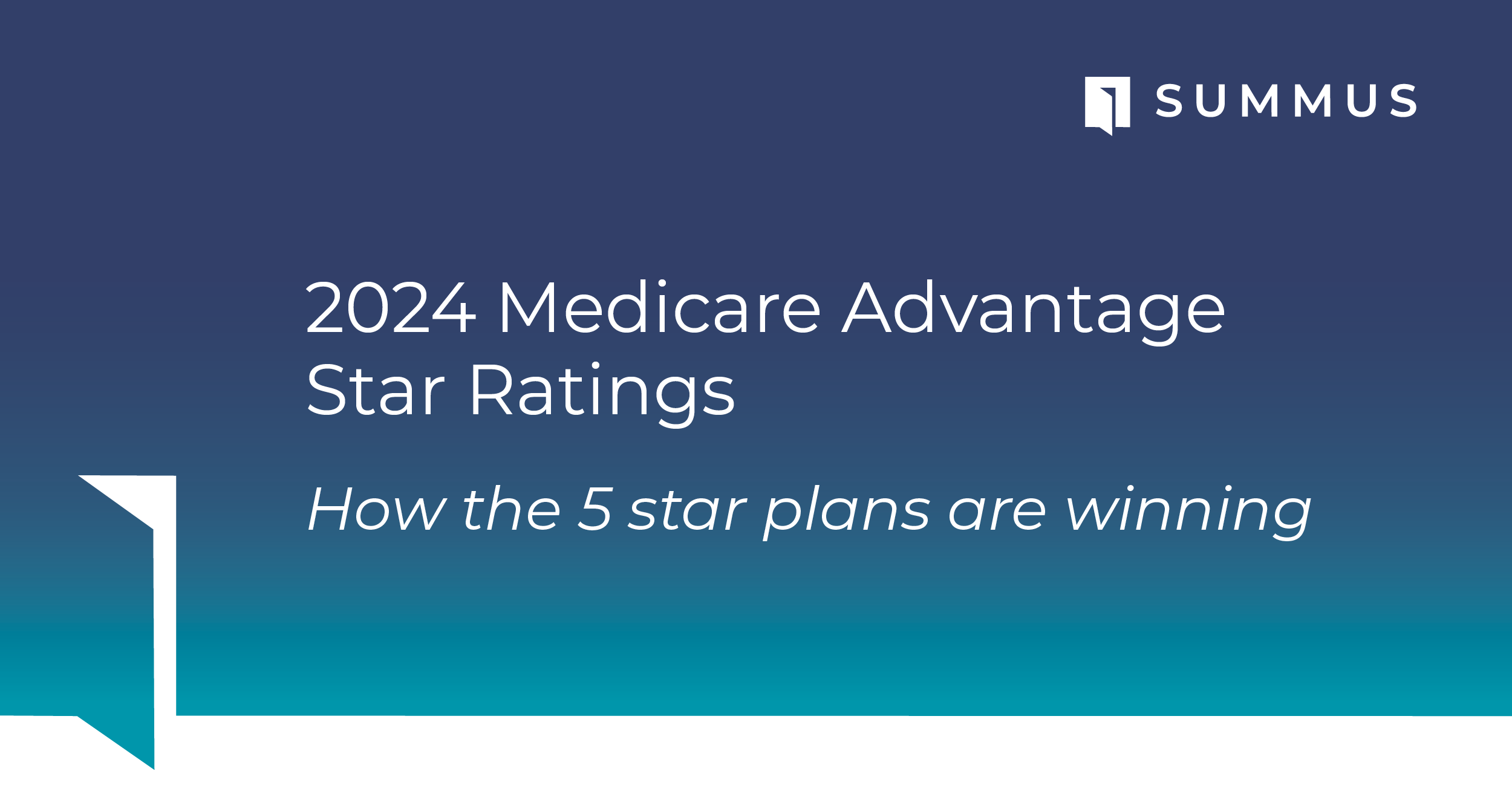Sarah Baker, MPH, Summus Senior Director, Product Marketing, Summus
Centers for Medicare & Medicaid Services (CMS) released the 2024 Medicare Advantage Star Ratings on October 13. The new cutpoint methodology has been a challenge for health plans striving to achieve a high Medicare Star Rating. For 2024, the number of 5 star Medicare Advantage plans went down by 45%. In 2023, there were 57 plans, this year there are 31. The new methodology means that while plans have a clearer view into what they need to score 5 stars, it is harder for many to achieve the score.
After reviewing the 2024 Star Ratings, we found that plans excelling—receiving 5 stars in 2024—stand out in three key areas. These areas are: member rating of the health plan, chronic care outcomes, and transitions of care.
CAHPS is the leading indicator of Medicare plan performance
If health plan leaders measure one thing, it should be the Member’s Rating of the Health Plan. The Consumer Assessment of Health Plans and Systems (CAHPS), specifically the Member’s Rating of Health Plan measure, is a key indicator of overall plan performance.
Of the 31 5-star plans:
- 26 scored 5 stars on the rating of health plan measure,
- One scored 4 stars, and
- Four were too small to include this measure.
Of the 109 plans that scored 5 stars on the Member’s Rating of Health Plan measure, 95% scored 4 stars or higher in the overall rating used to determine bonuses. Plans that rank the highest with consumers on CAHPS have an organizational strategy that enables their success on every other star measure.
Prioritizing member experience entails offering meaningful benefits, engaging your provider network in your goals, and a customer-first service culture. A plan that prioritizes a positive member experience builds into a strong brand. This encourages both members and providers to engage on important health topics and improving clinical measures. It is not possible to be successful in today’s Medicare Advantage environment without focusing on CAHPS score.
Chronic care wins through value-based provider contracts
While there aren’t as many chronic care measures in the 2024 Medicare Advantage Star Ratings as in previous years, high performing plans stand out. The 4.5 and 5 star Medicare Advantage organizations score seven to eight percentage points higher than the average plan on blood pressure control, blood sugar control, and diabetes eye exam measures. Preventive screenings and Health Outcome Survey measures don’t show the same substantial difference in scores between the high performing and average plans as we see with the chronic care measures.
Plans have experimented over the years with any number of member-focused programs to encourage preventive screenings and chronic condition care. The plans that are high performing have moved beyond member initiatives and are engaged in value-based contracting with their providers. Value-based contracting has resulted in greater success on the chronic care measures. These CMS Star Rating measures require a primary care provider to have an ongoing relationship with a member, providing guidance, education, and support to stay on track with treatments. This happens most consistently when providers are incentivized.
Transitions of Care stands out, but not Readmissions
The Transitions of Care measure, and the accompanying Medication Reconciliation Post-Discharge measure, are another area where high performing plans stand out. The 4.5 and 5 star plans score 12–13 percentage points higher than the average plan on these measures. These high-performing plans are not any better at achieving low rates of hospital readmissions. Their performance on Plan All-Cause Readmissions is average.
The goal of a transitions of care program is to reduce readmissions. So, we would expect that plans that are better at transitions of care show reduced readmissions, but they don’t. What’s more, this difference shows what it takes to win at CMS Star Ratings. Transitions of Care is a process measure—it’s a study of documentation in the medical chart. Readmissions is an outcomes measure looking at what actually happened to the patient after discharge.
A plan or health system could have a great care transitions program in place that produces low readmissions rates. Ultimately, if it’s not documented in the medical record, it didn’t happen. Plans (and their provider partners) who have exceptional documentation and data gathering, will continue to display an advantage over others. On the flip side, there are plans operating in areas with low readmissions. This could be due to their population or a delivery system that is focused on improving care coordination. These plans and systems can appear successful at reducing readmissions without the Transitions of Care measure.
What to expect
CMS will continue to shift the measures, finding new ways to differentiate high-performing Medicare Advantage plans. These changes will make it more difficult to reach the bonus category. After 13 years of changing measures, methodologies, and cutpoints, it is clear that there are core competencies in Medicare Advantage that must be maintained. Engaged providers, high member satisfaction, and clean data will always be fundamental to success in Medicare Advantage, as long as we have the Star Rating system.
Summus supports Medicare Advantage plans
For more information about how Summus helps Medicare Advantage plans, visit us here.






